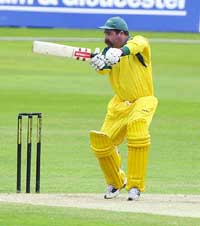Australia upset the form book - 1987
India's triumph in the 1983 World Cup gave the subcontinent's bid to conduct the competition four years later a tremendous fillip, and for the first time, the World Cup - labelled the Reliance Cup after the new sponsors - was held outside England,
Partab Ramchand
11-Mar-2003
India's triumph in the 1983 World Cup gave the subcontinent's bid
to conduct the competition four years later a tremendous fillip,
and for the first time, the World Cup - labelled the Reliance Cup
after the new sponsors - was held outside England, when both
India and Pakistan jointly hosted the event in October-November
1987.
Other than the overs per innings being brought down from 60 to 50
it would have been next to impossible to bowl 120 overs a day
on the subcontinent - there was no alteration in the teams
involved or the general format. Once again, the eight teams were
placed in two groups; Group A comprised India, Australia,
Zimbabwe and New Zealand, while group B comprised England,
Pakistan, West Indies and Sri Lanka.
 © CricInfo |
The pattern was set on the opening day, when Pakistan beat down a
spirited challenge from Sri Lanka, winning by just 15 runs. A day
later, England surprised the West Indies by two wickets, the
winning runs being scored with three balls to spare. Pakistan
defeated England by 18 runs and then got the better of the West
Indies in a scorcher, the final margin being one wicket and the
winning runs being scampered off the last ball.
By now the competition was becoming known as much for its nailbiting finishes as for its impeccable organisation. In the return
round of matches, Pakistan again defeated England to make sure of
a berth in the semifinals, and the battle for second spot now lay
between England and the West Indies. The two-time champions
seemed to be clawing their way back with two successive victories
over Sri Lanka, in the first of which Vivian Richards hammered a
majestic unbeaten 181 that surpassed Kapil Dev's 175 not out as
the highest individual score in a World Cup. But a second
successive loss to England knocked them out of contention, and
even though they beat Pakistan in their final league match
handing the co-hosts their first defeat in six games it was no
more than a consolation prize for the West Indies.
Things were less hot in the comparatively passive Group A but
only just. Intense competition was lacking for India and
Australia, who as expected were always ahead of New Zealand and
Zimbabwe. But close finishes were prevalent in this pool too. In
fact, the first match between India and Australia at Madras
produced the closest possible finish, with the latter winning by
one run. New Zealand and Zimbabwe then produced another thriller
the next day at Hyderabad before the former edged past their
gallant opponents by three runs despite a heroic 141 off 138
balls by Dave Houghton.
A few days later, Australia defeated New Zealand at Indore by
three runs in the only rain-affected match of the tournament.
Postponed by a day because of heavy rain, it was curtailed to 30
overs a side after captains Allan Border and Jeff Crowe expressed
their preference for a game rather than sharing the points for a
no-result.
The rest of the matches went according to the form-book, and
India, with five straight wins after that narrow loss, took the
top spot, while Australia with a similar record were second. Both
teams had 20 points, but India's slightly superior rate saw them
avoid a semifinal meeting with Pakistan at Lahore. Instead, they
took on England at Bombay, while Australia had to make the trip
to Pakistan.
At this stage, all seemed set for an IndiaPakistan final clash.
India seemed to be peaking just at the right time, while
Pakistan, in getting the better of West Indies and England in
their group, had shown themselves to be potential champions. It
was also the clash that everyone was looking forward to, a real
dream final.
Such dreams, however, were shattered, for it turned out to be an
AustraliaEngland final. Australia set one up for the underdogs
when they shocked Pakistan by 18 runs. The next day, England
maintained the trend by upsetting India by 35 runs. It was
unbelievable, but full credit went to both Australia and England
for displaying a professional approach against in-form opponents
who may have been a touch complacent.
Both matches followed a similar pattern. Australia scored 267 for
eight in 50 overs, and Pakistan seemed well-placed at 150 for
three, and with Javed Miandad and Imran Khan going strongly, they
required 118 runs off 15 overs. But Craig McDermott then got
among the wickets, and Pakistan were dismissed for 249 in 49
overs, with the tall and well-built pace spearhead finishing with
five for 44.
 © CricInfo |
The final at Calcutta evoked comparatively lukewarm interest in
the subcontinent, although 93,000 spectators were present at the
Eden Gardens. Though the final victory margin was only seven
runs, the match was not that close, for Australia always seemed
to have things under control from the time they led off with 253
for five in 50 overs. David Boon top-scored with 75, enough to
get him the Man of the Match award.
England had the benefit of sizeable contributions from most of
their top-order batsmen, but tight bowling and brilliant fielding
saw to it that they were always behind on the run-rate.
Ultimately they fell agonisingly short, finishing at 246 for
eight in 50 overs. Australia, then in the midst of a rebuilding
process and given little chance of winning the title, ended up
deserving champions.